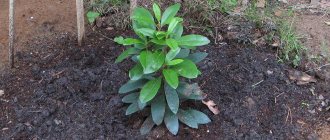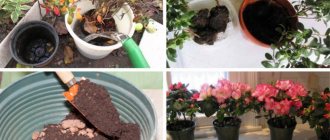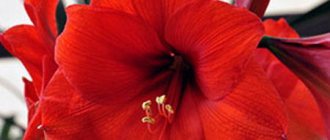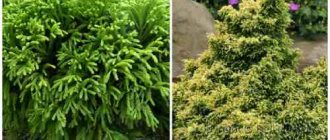The indoor azalea is a representative of the rhododendron genus and a close relative of the garden beauties - tall rhododendrons. There are several hundred species in the wild, but only two and their hybrid forms are grown at home.
The indoor azalea flower is a compact shrub 30–50 cm high with abundant and very beautiful flowering, which has made it popular among indoor plant lovers. Its flowers are lush, in shades of red, white and pink, there are varieties with lilac and two-color corollas. Azalea is also valued because it blooms in the cold season, when most other flowering plants are dormant.
Types and varieties of indoor azalea
There are two types of indoor azaleas.
Indian azalea (indica), or Sims' rhododendron (Rhododendron simsii) (1). The most popular type, it is the one that can most often be found on sale. It is an evergreen shrub with small dark green leaves with reddish pubescence. The flowers of this indoor azalea are simple or double, usually reach sizes of 3 - 5 cm or larger and are collected in round inflorescences.
Japanese azalea, or blunt rhododendron (Rhododendron obtusum) (2) . Less common. Its flowers are small compared to Indian ones and more neat in shape. Japanese azalea can also be grown as a garden plant.
As for the varieties of azaleas, they are mainly known only to collectors: in stores and shopping centers, hybrid azaleas are most often sold, which are usually called “Azalea white / pink / red” or “Azalea mix”, and sometimes simply “Azalea indica” . Azalea varieties may differ in flowering time: early winter or mid-winter - early spring. Unfortunately, it is unlikely that you will be able to find out such details when buying an azalea in a store - the characteristics of the variety (and at the same time its name) can only be found out when purchasing a plant from a collector.
The most famous of the old varieties are (3):
- Adventsglocken - a tall (45 - 50 cm) variety with single large (6 - 8 cm) raspberry-pink flowers that stay on the plant for up to 20 days;
- Vervaeneana - a tall variety with semi-double large flowers (8 - 8.5 cm) of pink color with a white border along the edges of the petals, blooms for 190 days;
- Max Schäme - tall, with double flowers with a diameter of 8 - 8.5 cm, petals of a salmon shade strongly corrugated along the edge, blooms for 130 days;
- White Niobe (Niobealba) is a tall (45 - 60 cm), spreading azalea with white double flowers with a diameter of 8 - 9 cm, blooms for 80 days;
- Schnee is a tall variety with semi-double white flowers, blooms for 130 days.
Caring for indoor azalea at home
Azalea is a capricious plant, demanding on growing conditions. This is due to the fact that in nature azaleas gravitate to cool mountain climates and certain types of soil (4).
Priming
The soil for indoor azaleas should be acidic; in neutral and alkaline soils, the plant gets sick and may die. Of the ready-packed soil mixtures, only special ones are suitable for it - for azaleas, rhododendrons, camellias and heathers.
Experienced flower growers prepare soil for azaleas on their own, but this is difficult for amateurs, and with this approach it is difficult to maintain the optimal acidity level required by the plant.
Indian azalea. Photo: pixabay.com
Lighting
Indoor azaleas prefer bright, diffused light; in direct sun, their growth is inhibited, and leaves and flowers can get burned. It is possible to grow indoor azaleas in partial shade, but in winter, during the period of bud formation and flowering, azaleas may require additional lighting with a phytolamp.
Temperature
One of the main difficulties in caring for an indoor azalea is providing it with a suitable temperature regime. Azaleas are cold-loving, the optimal temperature for them outside the flowering period is 15 - 18 ° C, and lush flowering is often stimulated by a decrease in temperature during the period of bud formation to 10 - 12 ° C.
Indoor azalea does not tolerate summer heat well; the upper limit it can tolerate is about 20 °C. Moreover, sudden changes in temperature also harm the plant, especially at the moment of formation of buds - in such conditions they can fall off and there will be no flowering.
Being in a draft is also harmful for azaleas, but periodic ventilation of the premises is beneficial for it. When growing azaleas in a city apartment, it is recommended to place them in the summer on a balcony oriented north or west, but in no case to the south. In winter, it is better to keep the plant as far as possible from heating devices; acceptable conditions can be provided for it on an insulated glazed balcony with moderate heating. If you live in a country house, the best place for an azalea will be a cool veranda or terrace.
Humidity
Indoor azalea requires high humidity, so it must be sprayed frequently. During flowering, this must be done especially carefully, because drops of water darken the flowers. You can spray water from a fine spray bottle around the plant, place containers of water next to it, or place the pot in a tray with damp sphagnum, expanded clay or gravel.
Japanese azalea. Photo: pixabay.com
Watering
Proper watering is another difficulty in caring for indoor azaleas. The plant requires moist soil, but with excess moisture it is very quickly affected by root rot. The earthen ball should always be slightly moist; drying out is unacceptable. During flowering, azaleas require more abundant watering than usual. After watering, the water remaining in the pan is drained immediately.
When the soil is dry or in the summer heat, a container with indoor azalea can be placed in a basin of cold water for a while. Some gardeners find it useful to alternate this type of bottom watering with regular watering throughout the year. When growing indoors, it is very useful to place pieces of ice on the soil in the pot instead of watering. Azalea tolerates cold well, and at high air temperatures, watering with cool water can partially compensate for keeping it too warm.
Water for watering azaleas should be soft, well-settled (for at least 2 - 3 days) - impurities contained in tap water can harm the plant. Lime is especially dangerous for it, since watering with lime water reduces the acidity of the soil. The plant also reacts very poorly to chlorine. About once every 10 - 14 days, you can add a few drops of lemon juice to the water for irrigation - this helps maintain the required pH of the soil and promotes abundant flowering of the azalea.
Fertilizers
Indoor azaleas are suitable only for special fertilizers for azaleas, rhododendrons and camellias, preferably in liquid form. Experts in growing azaleas sometimes recommend applying fertilizers with a high content of phosphorus and potassium and a low content of nitrogen during the budding period, but it is difficult for an amateur gardener to determine which proportions are considered correct, so it is better to refrain from experiments.
Azalea during budding. Photo: pixabay.com
Feeding
In spring and summer, fertilizers are applied along with watering once a week in the dosage specified in the instructions. In winter, fertilizing is applied much less frequently - once every 4 weeks.
Trimming
The formation of a beautiful dense bush in an indoor azalea is possible only with regular, proper pruning.
After the azalea has faded, be sure to remove the flowers and shorten the shoots by several centimeters. At the same time, sanitary pruning of the bush is carried out: all dried, weak and non-flowering shoots are cut off.
At the end of spring - beginning of summer, when young shoots appear on the bush, their tops are pinched. It is advisable to pinch the shoots throughout the season, until buds appear on the plant. At this time, you need to monitor the appearance of sprouts near the flower buds and carefully remove them. To prolong the flowering of indoor azaleas, fading flowers are plucked out one at a time.
Azaleas Knap Hill
An extensive group of hybrid plants, called Knap Hill Hybrid, was created by crossing several wild azalea species, including the Japanese variety, as well as plants bred from America.
The beginning of breeding work, which gave the world of flower growers many luxurious plants, was laid in the 19th century in the legendary British nursery Knap Hill Nursery. It was he who gave the name to the azalea mixes obtained by E. Vatarer.
Some of the seedlings of new hybrids were purchased by the famous billionaire collector and florist Lionel Rothschild. The plants were transported to Hampshire and here, on the estate of Baron Exbury, work on developing previously unseen varieties of azaleas continued. As a result, the world received flowers of amazing brightness, not only in traditional white and pink tones, but also in yellow shades.
On the site of the old estate, a luxurious garden with bushes of deciduous azaleas one and a half meters high is still preserved. The flowers have different colors and sizes; some specimens are striking even with 10-centimeter corollas.
Many Knap Hill azaleas emit a subtle fragrance, and most easily tolerate frosts down to 23 °C and even up to 30 °C.
Unfortunately, it was not possible to preserve all the hybrid azaleas from the old English group. Many were irretrievably lost, but the remaining plants became the basis for modern breeding work.
Azalea Golden Eagle (Rhododendron Golden Eagle)
A winter-hardy deciduous azalea, obtained from crossing Rhododendron calendulaceum and reaching a height of 1.8 meters in adulthood. A plant with a wide, rounded crown acclimatizes perfectly in the conditions of the middle zone and annually pleases the gardener with the appearance of a mass of yellow-orange semi-double flowers with a diameter of up to 6 cm. The flowers of this azalea variety form inflorescences of 6–12 pieces and do not fall for 3 to 9 weeks.
Azalea Knap Hill Sylphides
This deciduous azalea variety also belongs to the Knap Hill Hybrid family and is considered one of the most frost-hardy in the world. Plants resist frosts down to –32 °C and in spring open 8–14 large funnel-shaped flowers on each shoot. The background color of the corollas is white and pink, with a bright yellow spot in the middle. This variety of azaleas does not have a pronounced aroma. Mass flowering occurs in May and June. An adult bush has a dense spherical crown up to 120 cm high.
Azalea deciduous Jolie Madame
Tall compared to the azalea varieties described above, the Jolie Madame bush also survives frosty winters well, but by the age of 10 it can grow up to 3 meters in height. The flowers of this deciduous azalea are large, simple and bright pink. There is a barely visible orange-yellow spot in the center. The peak of flowering occurs in June, when 7–9 flowers open on the shoots.
Azalea Knap Hill Schneegold
The spectacular deciduous azalea is obtained by crossing the yellow rhododendron variety Saint Ruan and Cecile. Plant growth in gardens is limited. As a result of pruning, a crown is formed with a height and width of about one and a half meters, but without control, the azalea can grow up to 2 meters in height.
The flowers are large with white petals wavy along the edge. But the azalea cannot be called white, since the top of the corolla is decorated with a yellow spot, and the bottom edges have a pink blush. Flowering occurs in May and June.
Azalea Knap Hill Csardas
This hybrid variety, derived from the yellow rhododendron, is also a member of the Knap Hill azalea group. The flowering of the variety begins in May, when the meter-high bush is covered, as in the azalea photo, with yellow-cream double flowers. A fragrance spreads around the plants. The difference between this azalea variety is its love of sunlight. The plant grows well and blooms on the sunny side; in the shade, the brightness and size of the corollas noticeably decreases.
Azalea Knap Hill (Rhododendron yellow) Satan
One of the brightest azalea varieties from the English group is called “Satan” and stands out for its simple scarlet flowers with a yellowish tint inside the corolla. The height of the light-loving upright plant reaches 180 cm. When planting, it is recommended to choose well-lit places with loose, drained soil. The peak flowering of this azalea, as in the photo, falls in the last ten days of May and throughout June.
Azalea hybrid "Slavka" (Knap Hill group)
The flowers of this variety of azalea have not only a pure white color, but also an amazing double structure, as if one corolla is inserted into the other. An elegant white azalea will decorate any garden and can be used both in single and group plantings. The height of the bush is small, only 1–1.4 meters, the crown is spherical and compact.
Azalea Golden Lights (Rhododendron Golden Lights)
A spectacular plant with bright lush flowering and extraordinary frost resistance will not be lost in any garden or greenhouse. This is a deciduous azalea, bred by American breeders at the University of Minnesota. The azalea hybrid Golden Lights belongs to the American Northern Lights group. An adult bush reaches a height of 150 cm and from May to June is lushly decorated with golden-yellow flowers 7 cm in diameter. For a plant, like the azalea in the photo, shaded, quiet places with abundant watering and an acidic substrate rich in humus are preferred.
Azalea hybrid Azurro
Huge flowers of the Azzurro hybrid appear from the end of May and last until mid-June. Deciduous azalea bushes up to 1.5 meters high are strewn with thousands of flowers of a juicy purple-blackberry color with crimson splashes inside the corolla.
Azalea deciduous Koichiro Wada
Azalea species yakushimanum belongs to the Asian varieties of the plant. The Koichiro Wada variety stands out among its relatives for its bright pink buds, which fade when the corollas fully open. Gradually, the cupped flowers become completely white. The leaves are dark green, leathery, dense, but they are almost invisible due to the mass of azalea flowers, as in the photo, covering the crown until mid-June. The ornamental shrub grows up to 140 cm in height and 220 cm in width; it is very frost-resistant and not picky when grown in the garden.
Propagating indoor azaleas at home
Indoor azaleas are propagated by semi-lignified cuttings. It is not always possible to propagate them at home: the process itself is simple, but does not always produce results. Cuttings are cut in the summer from young shoots at least 6 months old, the stems of which have just begun to become lignified. The stalk should have a length of 7 - 10 cm and several pairs of leaves. It is cut diagonally with a clean, sharp knife, the leaves are removed, leaving only the top few. The lower part of the cuttings is dusted with Kornevin and planted to a depth of 2 - 3 cm in azalea soil or a 1:1 mixture of sand and peat. The substrate is well moistened, the container is covered with a transparent material and kept in a warm place at a temperature of 24 - 25 ° C. The plantings are ventilated every few days and the soil is kept moist but not wet. Flower buds may appear on the cuttings - they must be removed immediately.
Rooting usually takes 1.5 - 2 months; a signal that this has happened is the appearance of young shoots. After rooting, the shelter is removed, the cuttings are grown a little more and planted in separate containers.
An overgrown indoor azalea bush can be propagated by division, but this is an even more risky method: the azalea's root system is very fragile and sensitive, so the plant may not tolerate intervention.
Varieties of indoor plants with names and what they look like
In nature, there are about 350 species of this plant; the jasmine variety is very spectacular. Only two are suitable for growing at home: Japanese Azalea and Indian Azalea. Breeders are working to develop new, hybrid varieties. Flowering of a houseplant occurs only in the 3-4th year of its life, but already mature, flowering specimens are more often found in stores. In most cases, the color of the petals is pink, but other options can be easily found.
Japanese azalea (Rhododendron obfusum)
What is the name of an indoor flower with red flowers?
The Japanese variety is grown in pots much less frequently than the Indian variety. The leaves of this shrub are small, dark green, up to 5 cm in length. The flowers are small, funnel-shaped, and can be painted in different colors.
Interesting! Japanese azalea is a frost-resistant plant and is often grown as a garden plant. The variety can withstand even severe frosts, down to -20 ° C. But before planting, it’s worth learning how to care for azaleas outside the home.
Japanese white azalea
Indian azalea (Rhododendron x indicum, Azalea indica)
The variety has another name - Sims rhododendron. For home growing, it is often preferred. Its distinctive features:
- The height of the evergreen shrub reaches 50 cm.
- The leaves are small (up to 4 cm in length), glossy, dark green on top. The lower part is light green in color, covered with small reddish hairs; the young stems of the plant have the same pubescence.
- The leaf petiole is short.
- Flowers double or simple. Their shape is funnel-shaped, diameter 3-5 cm. They are collected in inflorescences and open simultaneously.
- Azalea flowers come in different colors, from white to bright red. There are both monochrome and two-color.
Sims' rhododendron
Transplanting indoor azaleas at home
Indoor azaleas are replanted only after flowering, when the flower is in a dormant period. Young plants need to be replanted once a year. Upon reaching the age of 3 - 4 years, the azalea is replanted every 3 years or less.
A sign that it is time to replant the azalea flower is the roots coming out of the drainage holes of the pot or visible above the soil surface. You need to replant indoor azaleas very carefully: as already mentioned, the roots of the plant are weak and easily damaged, and the root system itself is superficial and lies shallow. When transplanting azaleas, the earthen ball is not destroyed and the roots are not unraveled.
The new container for azaleas should be slightly larger than the old one (2 - 3 cm), and a drainage layer must be laid at the bottom. The azalea is placed in a new pot so that the root collar is at the same level as before. The soil is poured very carefully, without compacting, but only lightly pressing with your fingers.
After transplanting, the azalea is watered and, if necessary, topped up with soil if it settles.
Reproduction
There are methods of varying degrees of complexity: by seeds, cuttings, dividing the bush or layering. The first of them is not the most rational, so it is rarely used. The second method, cuttings, is considered simple. But the simplest and most effective is propagation by layering. Let's describe it briefly.
Select the longest shoot at the edge of the crown, bend it to the surface of the ground and pin it so that the bud is slightly buried in the ground. After a few months, the cuttings will take root. Then it can be separated from the mother bush and grown in a separate container.
Diseases of indoor azalea
Gray rot . It appears in the form of putrefactive spots on leaves and shoots, often with a gray “velvety” coating. The affected tissues soften and die, and over time the entire plant dies. The cause of gray rot is poor care and improper watering.
For treatment, all rotten parts of the plant are removed, and the soil in the pot is dried. It is advisable to treat the plant and soil with fungicidal preparations that do not contain chlorine and lime - these can be the biological preparations Fitosporin-M or Fitolavin, or a universal chemical fungicide, for example, Fundazol (5).
Root rot. Most often it appears due to excessive watering and stagnation of water in a pot or tray. Leaves wither throughout the plant, shoots become lethargic and may droop and lie down. The exact cause of the problem can only be determined by removing the plant from the pot: blackened, slimy, easily separated roots become visible.
To save the azalea, such roots are removed, the root system is soaked in a solution of potassium permanganate or a fungicidal preparation, then the plant is transplanted into new soil. Even if treatment is started on time, the azalea's chances of surviving the onset of root rot are slim.
Late blight . A dangerous disease of indoor azaleas, which is not always curable. The first signs are brownish spots with a light border on the leaves. Over time, they increase in size and parts of the plant begin to die off.
It is possible to save an indoor azalea infected with late blight in very rare cases. To do this, the affected parts are removed, the plant is treated with fungicides (Consento, Revus, Ordan (5)) and transplanted into new soil.
Chlorosis . The leaves turn pale and discolored, first between the veins, then throughout the entire leaf blade, dry out and die. The cause of this disease is not infection, but insufficient soil acidity. This happens, for example, when watering with unsettled or very hard water.
The problem is solved by adding lemon juice or citric acid to the water for irrigation; in severe cases, you will have to replant the plant in fresh soil with sufficient acidity.
Frost-resistant varieties
Some members of the azalea family are able to survive winter frosts, and they are simply grown in open ground in the partial shade of the garden.
Garden azalea (Rhododendron Garden Azalea)
This frost-resistant variety is practically never found indoors. A low bush with shiny leaves is densely decorated with beautiful funnel-shaped flowers.
White azalea (Rhododendron Azalea white)
During flowering it vaguely resembles jasmine. It blooms with simple and double flowers of white or pink color. If planted next to a more saturated color of azalea, the white will immediately turn white.
Rhododendron Goldflimmer
Delicate lilac inflorescences framed by dark green leaves with yellow strokes in the middle. Requires shelter for the winter. Able to withstand frost down to -17 degrees.
Apple blossom (Rhododendron Apple Blossom)
A deciduous bush that produces leaves every spring. Requires shelter in winter and protection from the sun in early spring.
Ramapo (Rhododen Ramapo)
It blooms in May with lilac-pink inflorescences of several flowers, which generously dot the bush. Amenable to crown formation. Over the course of a year it grows by 5-10 cm, reaching a height of 60 cm by the age of 10 years.
Pests of indoor azaleas
The indoor azalea flower is affected by the same pests as other indoor plants: spider mites, scale insects, aphids, whiteflies and thrips.
If there are few pests, washing the plant with green soap helps; in extreme cases, you can use household soap. The procedure is repeated 2-3 times at intervals of several days.
In case of severe infestation of aphids or whiteflies, the plant can be treated with Actellik or Fitoverm; for spider mites, scale insects and thrips, Aktara is recommended (5). If the azalea blooms at this time, the flowers will have to be sacrificed: after spraying with the preparations, they will lose their decorative effect.
Diseases and pests
Houseplants are susceptible to diseases, and azaleas are no exception. To grow a healthy plant, you need to inspect the foliage daily and, at the first signs of disease and the appearance of pests, treat it with chemical or folk remedies.
Common Pests
Greenhouse whitefly
A barely noticeable insect with a pale yellow body and white wings. Settling on the vegetative parts of the plant, the whitefly sucks out the juice. As a result, the foliage loses color, curls and falls off.
The insect leaves behind a trail of sugary secretions, on which sooty fungus subsequently develops.
Greenhouse whitefly
Chemical control measures If there are small children in the house, it is better to treat the plant with garlic infusion or hang adhesive tape near the azalea pot designed to catch flies.
Azalea moth
Young caterpillars prefer soft tissues, so they hatch in the axils of leaves. The fact that a pest has infested is indicated by drying of the leaves - if you touch them, they will crumble.
Azalea moth
Adults can be seen on the underside of the leaf. Caterpillars pupate in pre-twisted shield-like cocoons.
Control measures To get rid of the pest, it is necessary to fumigate all specimens with sulfur.
Furrow weevil
Black, large beetle, up to 10 cm in length. The body of young individuals is colored yellowish-brown. Individuals are not particularly mobile, but if startled, they fly away.
Furrow weevil
They feed on vegetative parts: leaves, stems, buds, buds, flowers. The grooved weevil or weevil is capable of constantly reproducing, which leads to rapid development of the population.
Control measures: Karbofos is used to exterminate the pest. Folk remedies include infusions of tobacco, onion peels, and garlic.
Since the weevil prefers to cause damage in the dark, plants should be sprayed late in the evening.
Common azalea disease
Fusarium wilt
During transplantation into new soil, at high temperatures, fusarium fungus may form
The leaf blades wither and dry out. The plant may die. Prevention measures. Keep cool; during replanting, Fundazol should be added to the soil.
The disease should be fought in 3 stages:
1Spray the soil with Fundazol;
2After a week, water with any antibiotic dissolved in water;
3After 7 days – with a solution of potassium permanganate
Problems when growing azaleas: question and answer
It would seem that a beautiful plant is standing and, suddenly, the leaves begin to turn yellow or black, then they dry out and fall off. Let's try to consider all the questions regarding problems with cultivation and give them a comprehensive answer.
An azalea bush is shedding its leaves. What is the reason?
For active growth of azaleas, conditions close to their natural growing environment are required. The plant does not respond well to excessive watering, but it will not grow in dry soil. Therefore, the golden mean is important.
Azalea bush sheds its leaves
- Cannot be grown at high temperatures, best kept cool.
- It is necessary to constantly maintain optimal humidity.
- You can place a tray with wet pebbles next to the pot.
During flowering, you cannot spray the azalea, otherwise the bush will lose its decorative effect.
To avoid leaf fall, watering with soft water is required. Another reason is spider mites. The insect sucks the juice from the vegetative parts of the plants, so the flower lags in growth.
The leaves curl and fall off. To combat ticks, use chemicals or a soap solution. After treatment, you will have to cut off all the flowers, as they will become unattractive.
Yellowing leaves
The problem lies in the high calcium content in the soil. It is necessary to water the plant with acidified water at room temperature.
If the azalea has a scale insect, the leaves will also turn yellow.
You need to take a good look at the shoots, and if dark plaques are visible on them, these are scale insects. It is very difficult to fight them, since their body is covered with a chitinous layer. That is, pesticides will not help.
Let's talk about the right way to fight scale insects. Tested and effective. The infected specimen should be kept away from charged plants.
Wet the sponge with laundry soap until foam forms, then wipe all the shoots with it. Leave for 20 minutes. Then use another sponge to go over the branches and remove the scale insects.
You need to buy sewing machine oil at the store. Dilute 1-2 drops in water and spray on the infected specimen. The fact is that the oil creates a protective film on the stems of the azalea and the scale insects will no longer be able to “stick” to the shoots again.
Leaves are drying
If the leaf blades dry out and fall off, the reason is the appearance of a pest: azalea moth. If the leaves are firmly attached to the petioles, there is insufficient humidity in the room.
Diseased azalea leaves
The dying off of foliage after flowering is considered a natural process. But if leaf fall occurs during bud formation and flowering, this indicates a lack of nutrients.
Adaptation period after purchase
A clear sign of a flower’s successful adaptation to new conditions is the formation of new shoots and the appearance of flowers. After acquisition, indoor culture needs special attention and care. It is not recommended to place the plant near switched on radiators and radiators , since high room temperatures are contraindicated for it.
Low humidity levels should not be allowed - this is detrimental to an azalea flower that has not yet adapted. The rule here is: the cooler the better.
Adding nutritional formulations immediately after purchase is also contraindicated. This is due to the fact that in nurseries, azaleas are planted in already overfed soil so that they can safely withstand transportation over long distances and maintain their healthy appearance. At home, the biostimulator Epin will help speed up the adaptation process , which will stimulate the plant and increase its level of stress resistance and protection. Use the drug in accordance with the manufacturer's instructions; treatments can be done once every 10 days.
Varieties - description and photo
There are two main varieties of white azalea.
Japanese, or Rhododendron obtusum
A charming plant with small flowers. Its branches are literally strewn with them, it seems as if there is snow on them.
Indian, or Rhododendron simsii
White flowers have an original colored border around the edges and crimson dots on the petals.
White azaleas are very beautiful, but this is not the only color of the plant's buds. On our website you can read about pink azaleas.











